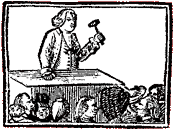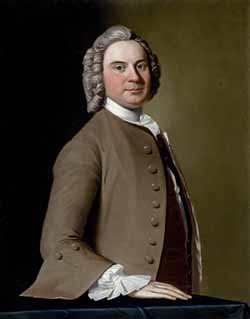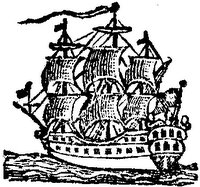As I
described yesterday, on 7 Sept 1768 the
Gloucester merchant
David Plumer directed a
mob to a house in the Annisquam village, seeking the
Customs informant who had cost him a shipload of undeclared
molasses.
When those men couldn’t find that man,
Samuel Fellows, they attacked the family he was staying with, the Savilles. The head of that family,
Jesse Saville, was out. Though officially a tanner, he, like a lot of Cape Ann men, probably also worked at fishing.
Here’s the rest of Jesse Saville’s description of that day:
I was not at home but was about two miles of by water, neither could i git home by reason of the tide. I came home about ten a Clock at night, very Darck and Raney. Had ocation to go out of Doors so tock my gun for I was affraid without her.
Meanwhile, two men in the mob, Joseph York and Thomas Griffin, woke up a neighbor and friend of the Savilles called George Dennison. According to Saville, they “told him they were coming to tare Down our house.” Dennison said he would be right with them. Then “After giting them out of Doors, [Dennison] fastened his Doors, went to Bed.”
But there were still dozens of men ready to confront Jesse Saville:
A few minuets after I was gone out a Doors they Sorounded our house attemting to Come in. My father was then in bed. He told them They Should not Come in Such a maner but they might three or fore of them come in and Sarch the house. A grate number flocked in headed by Dudley Sargent, marchant. Daniel Warner they Chose as Clark. Thomas Griffin above menteioned & Joseph York: were preasious in this mob.
I love the detail that this crowd mobbing a house chose a clerk, as if they were a town meeting or a charitable society. That reflects how they thought they were doing important community work.
I Stod a Little way of them, heard them Sware they would Tare Down the house, but what they would have him. I made a pass to go into the Door. They Sorounded me. I asked them who was there, was ansered by Dudley Sargent, half a Dozen of us. I asked what half a Dozen of such black gard Did there. They ansered me, Dam you we will tell you. They said where is Sam Fellows. I ansered none of your bysness.
They Imeadatily Seased me. About Eight or thereaway told me to Let go the gun I posessed. Desierd a pass into the house. My mother Cryd. out Jesse is dead. My wife fainting away. They nocked me Down, Toock away my gun, fired it of, broak it in peaces over a Rock. My father halled me into the house by the feet as I Lay on the ground.
It was Terable to See the wimans Countanences and the Cryes of the Children for part of the Children was at School in the Day time. So they Left the house after I threating them in the Law. Job Gallaway of the sd. town Told my wife he new the Person Struck me Down and broak my gun.
We were affraid to go to Sleep Ever Since Safly for word has been threatned to tare Down the house Several times and if Ever they Cached me in the harbor they would Serve me as bad as they would Capt Felows or if they Ever Could find out I Conseald him or by any means aided him or gave him any Sustanance they would tare Down the house and mob me which Since I Daresnot appear to profacute my Bysness but Shall be obliged to Leave the Town.
If I want to go out of Town I am obiliged to go and Come in the night or on the Sabbath Day.
Three days after the attack on the Saville home, locals “rescued” or grabbed back another shipload of molasses that the Customs office had seized.
But then the tide turned. At the end of September,
Royal Navy ships carrying two regiments of the
British army arrived in Boston harbor. Some of those ships started to patrol around Cape Ann. Royal officials became more bold. By the end of the October, the
Salem Customs office had seized David Plumer’s whole
Earl of Gloucester ship for smuggling.
Around 1 October, Jesse Saville went into Plumer’s shop. In his characteristic spelling, Saville stated, “I told him he must mack good the Dammage I had sustained.” Plumer replied that if the tanner wanted satisfaction he’d have to sue; also, “he said they wanted another frolick, they Did not Desier no beter Sport.”
On 14 October, Saville wrote out a long complaint about what had happened to his family for the Customs Commissioners in Boston. He named names, including prominent men like Plumer, fellow merchants Paul Dudley Sargent and Joseph Foster,
physician Samuel Rogers, and as many more as he could identify and remember:
- “Elichander Smith, Block macher”
-
“Lebeday Day, mason”
-
“William Lowder, tinman”
-
“David Day, shoemaker”
-
“Philemon Haskel, Black Smith”
-
“Daniel Warner, Black Smith”
Saville also filed suit in the local courts against Plumer and other neighbors. In early November a grand jury sitting in
Ipswich indicted eight Gloucester men “and others unknown” for attacking Saville’s house. The defendants included Rogers, Sargent, Foster, four other men Saville had singled out as violent, and two additional names: cordwainer Parker Knights and yeoman William Tarbox.
David Plumer wasn’t charged with assault, probably because he’d refrained from going into the Saville house or physically attacking anyone himself. But the Customs Office hauled him into Admiralty Court for smuggling. Plummer hired
John Adams as his lawyer but lost the case in December. The Customs office put his schooner
Earl of Gloucester up for auction in April 1769.
Since all those developments were bound to make him unpopular locally, Jesse Saville threw his lot in with the royal government. By the spring of 1769, he was working for the Customs service.
TOMORROW: And how did that go?














